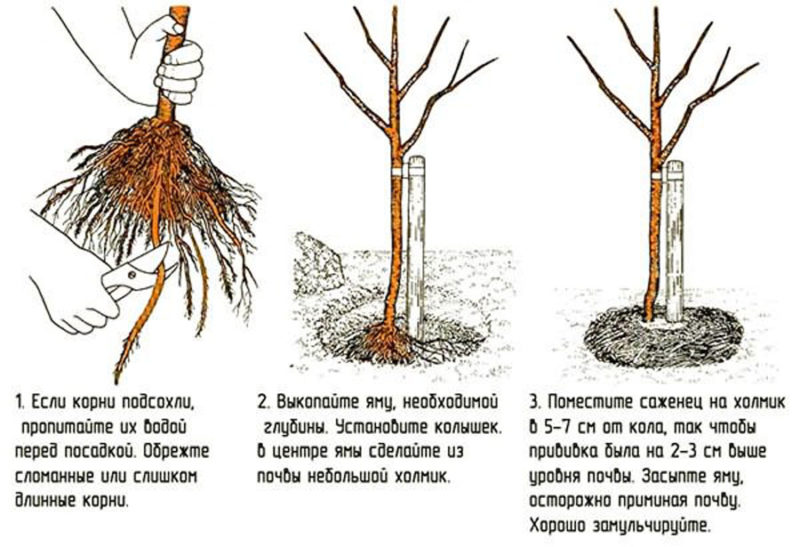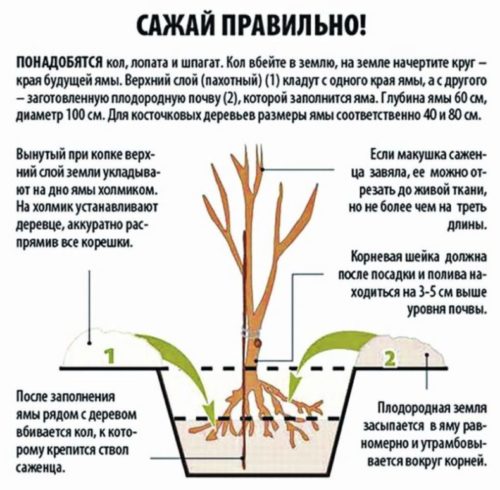A step-by-step guide to planting a closed-root apple tree in summer
Planting apple trees requires certain knowledge and skills from the gardener. The development of the plant in the future depends on how correctly the procedure is carried out. It is important to choose a suitable place, prepare the soil and planting material in advance.
Most gardeners agree that it is easier to work with seedlings with a closed root system. Consider how to properly plant such an apple tree and what nuances to take into account.
The content of the article
Features of apple seedlings with a closed root system
Seedlings with a closed root system (SCS) is called planting material, the roots of which are in an earthen coma. This form of plants is popular, it is increasingly used by professional nurseries, and there is an option in gardening markets.
Typically, closed-root planting material is grown in pots or containers. Usually in this form it goes on sale. There are seedlings with an earthen lump wrapped in a bag or bags.
Seedlings are sold that were rooted in the open field or greenhouse, and then simply dug up along with the soil adhered to the roots. This option is also considered ZKS.
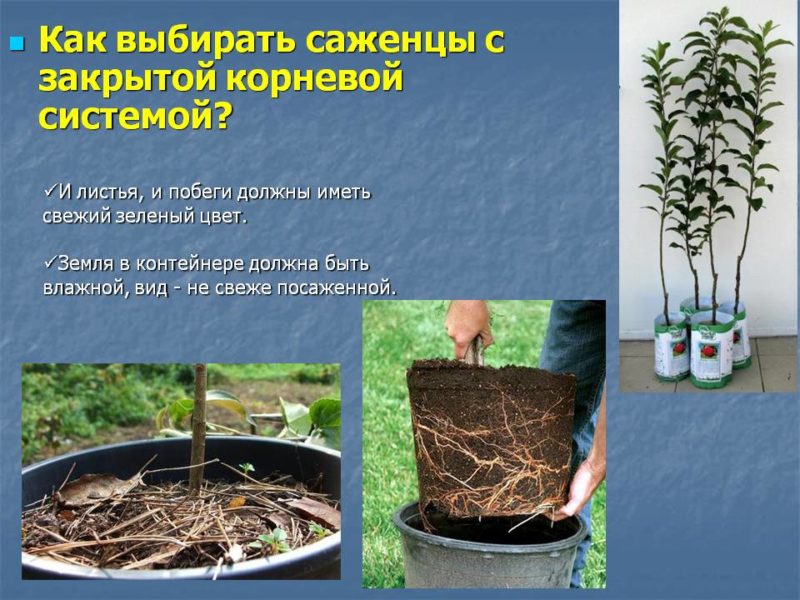
Pros and cons
Agronomists recommend planting material with a closed root system. It has several advantages over bare-root specimens:
- Due to the fact that all the roots are in an earthen coma, the risks of damage during transplantation are minimal. Even small roots remain intact, which break if they are opened.
- Such seedlings take root faster and take root in a new place. The plant experiences less stress during transplanting compared to ACS (open root system). The risks of death are minimal.
- Planting material from ZKS is planted throughout the summer. Of course, if the procedure is carried out at a suitable time, the result will be better, but even when planted in summer, the plant will not die.
- The roots in an earthen coma do not dry out. You don't have to dig up a tree for sale - they take it out of a pot with adhered earth. It is easier to buy high-quality viable planting material with ZKS than with OKS.
- Planting trees with a closed root system is easier than planting an open one.
Instances with a closed root system also have disadvantages that are important to consider when buying:
- It is problematic to check how developed the root system is and in what condition it is, since the roots are hidden in the ground.
- In the first year after planting, the development of the apple tree will be slowed down. This is due to the fact that roots, accustomed to a cramped container and potting soil, begin to grow and crawl out of the coma. Growth slows down due to a sharp increase in space and a change in the composition of the soil.
- Often, seedlings with a closed root system are more expensive than an open one, and weigh more.
To reduce the stress of the plants during transplantation, at first the same fertilizers, with which the apple tree was fed in the nursery. It is advisable to check the type of dressing with the seller.
Features of planting such trees
Planting trees with open and closed root systems does not differ much, but there are still several nuances:
- Specimens with open roots require lengthy processing.They are first washed in a solution of copper sulfate, then soaked for a day in a root formation stimulator. In the case of a closed root system, this is not done. The top of the plant is simply sprayed with a disinfectant and the bottom is watered in a pot or after planting.
- Seedlings with an open root system are planted on an earthen hill, evenly spreading around the roots. An apple tree in a coma of earth is simply placed in a hole.
- Instances with ACS are immediately prepared and planted after purchase. An apple tree with ZKS will calmly stand in a pot for a long time.
Landing dates
Closed-root apple tree planted in spring, summer and autumn. Each option has advantages and disadvantages. The best results are achieved when planting at the optimal time.
Spring
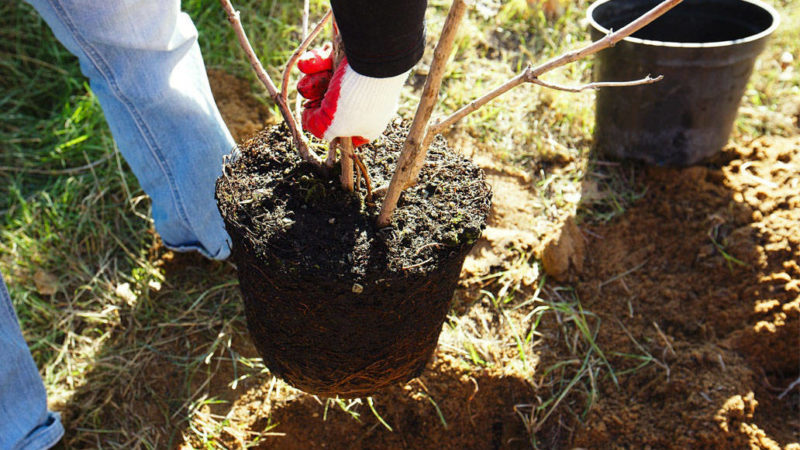
Most gardeners prefer to start growing fruit trees in the spring.
Planting at this time of year has a number of benefits:
- Rapid development of the root system. The tree is just beginning to wake up after wintering, sap flow is still slow, leaves are not yet formed. The forces of the plant are directed not at the growth of green mass, but at the growth of roots.
- Good soil composition. The soil rested all winter, so in the spring it is saturated with nutrients, which has a positive effect on the state of the planted plants.
- Before the onset of cold weather, the tree has time to get used to new conditions and get stronger. It will easily endure the upcoming wintering.
There are no significant drawbacks in this case. It is important to choose the right timing for planting: work is carried out when the soil has already warmed up, but the buds have not yet woken up. The month depends on the region.
In the center of Russia (for example, in the Moscow region) this happens from the beginning to the end of April. In the southern regions, apple trees have been planted since the end of March. In the northern zone (in the Urals, in Siberia), landing is possible from late April to late May.
Attention!To prevent the plant from dying during night frosts or exposure to open sunlight, it is hardened. To do this, the container with the apple tree is taken out into the street, gradually increasing the time spent there, bringing it to a whole day.
When buying, it is better to ask the seller about the growing conditions of the seedling. If he hibernated outside, hardening is not needed with a closed root system.
Summer
There are many drawbacks in summer landing and practically no advantages. It is used if the plant cannot be planted at another time.
Cons of summer landing:
- The seedling is actively developing green mass. The development of the root system will be slow.
- In summer, the weather is usually dry, and the soil is already partially depleted. To compensate for this, you will have to put more effort into caring for the plantings.
- The scorching sun negatively affects the health of newly planted apple trees. Without proper precautions, the plant will die.
Can you plant a tree in summer? Yes, but you will have to put in more effort and choose the right timing. You can plant the plant in June (preferably at the beginning) and the first few days of July.
From the second week of July to the end of August, it is better to refuse planting: at this time, the plant spends energy on the formation of fruits. If you drop it, it will hurt and die.
Attention! If the spring was cold and lingering or the site is in the northern region, in early June planting conditions will be close to spring.
In summer, planting is carried out only in the early morning or evening, when the sun is not active. On hot days, it is better to postpone the procedure to rainy or cloudy weather.
At first, the tree is shaded from the sun with a large sheet or other cloth. Spraying is carried out in the morning and in the evening. Make sure that the soil in the hole is always moist.
Fall
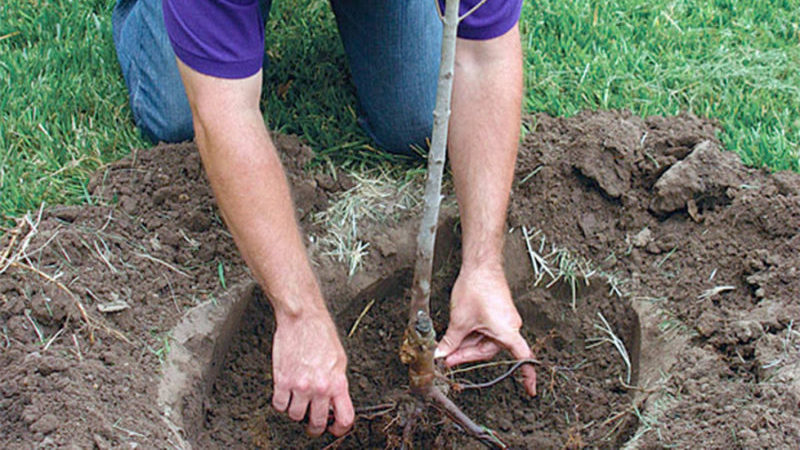
This period is favorable for planting trees. Main advantages:
- The growth of green mass has already been slowed down. The plant will spend energy on the development of the root system.
- The soil is still warm, but the scorching sun is gone. Such conditions are comfortable for plants after planting.
- The seedling will survive the winter.Trees planted in autumn are highly resistant to negative environmental factors and have good immunity.
If the rules of autumn planting are not followed, the plant will not survive the winter. To avoid this, it is important to have time to plant it at least 14 days before the first frost.
A hole is dug deeper in the fall and a large layer of fertile soil is poured onto the bottom. The trunk circle must be covered with a thick layer of mulch. The trunk itself is wrapped in covering material or surrounded by a net filled with fallen leaves.
It is interesting:
A beginner gardener's guide step by step: how to plant an apple tree in spring
How, when and how to spray apple trees in the spring against pests and diseases
Preparatory work
To grow a healthy, strong tree, it is important not only to plant it correctly and provide good care, but also to pay enough attention to preparing for planting.
Seat selection and preparation
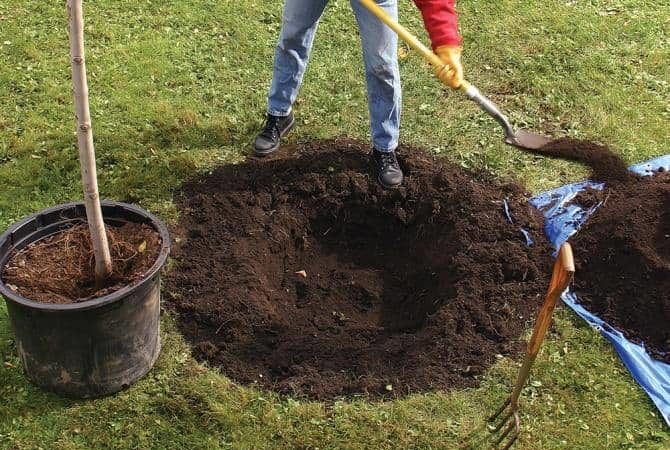
A well-lit and ventilated area is chosen for the apple tree. It should be protected from the winds by walls of buildings or tall trees planted from the north or north-west side. The apple tree should not be shaded.
Wetlands and areas with groundwater levels closer than 2 m are not suitable. If possible, the apple tree is planted on a hill. The south, southwest, southeast sides are best suited.
The distance from fruit trees to fences and neighboring buildings is regulated differently in each area. Usually it is about 4 m. The distance to communications should not be less than 3 m, otherwise the roots of the plant will destroy them.
Apple trees grow best in loose, fertile soils (loam, sandy loam, black soil). The soil should be slightly acidic and non-saline.
The plot begins to be cooked at least 6 weeks before planting. The soil is cleaned of debris, leaves, plant residues, dug up and leveled. Fertilizers are applied to the entire site or individually to planting holes.
The soil on the site is not always suitable for apple trees, but in most cases this can be adjusted:
- Close occurrence of groundwater... The problem is solved by choosing the right variety. If the depth is more than 1.5 m, semi-dwarf varieties are suitable; at 1–1.5 m - columnar and dwarf plants. Another option is to make a bulk mound for the apple tree.
- Sandy soils. Such soil is unable to retain nutrients and moisture. To neutralize this deficiency, holes are dug with a depth and diameter of 1.2 m. A 20 cm layer of clay is laid at the bottom, the rest of the space is filled with a mixture of black soil, rotted manure and peat in a ratio of 3: 1: 1. In sandy soils, the apple tree requires frequent feeding.
- Clay soil. The soil promotes moisture retention. Under such conditions, the diameter of the planting pit should be 1.2 m, and its depth should be 15–20 cm below the beginning of the clay layer. The bottom of the pit is covered with drainage (layer thickness - 15–20 cm). The rest of the volume is filled with a mixture of black soil, humus, peat and river sand (3: 1: 1: 1.5).
- Peat soil... Peat usually indicates the close occurrence of groundwater. It is better to check this parameter. The increased acidity inherent in such soil is reduced by adding dry lime. To improve the composition of the soil, 4 m³ of river sand is added per 100 m². Fertilizers are applied: for 1 m² - 6 kg of humus, 200 g of superphosphate, 4 kg of ash.
Preparation and selection of planting material
First, it is important to learn how to choose high-quality seedlings:
- The plant should not have spots, damage, cracks in the bark, growths, others signs of disease and pests. The branches should be flexible and not dry.
- Age - not older than 2 years... Usually one year old planting material is used. To determine the age, look at the number of branches. One-year-old seedlings do not have them, two-year-old have 3 branches.
- Height - within 1-1.5 m. Tall apple trees will grow higher than dwarf ones.It is not recommended to take trees that are too tall or low: this indicates improper care.
- The roots should not stick out from the earthy coma... It is important that the percentage of broken roots is minimal. If the earthen lump falls apart, then the tree was planted in a pot shortly before the sale.
- It is not recommended to choose foreign varieties, as they take root worse. It is better to choose zoned, adapted to the local climate.
The preparation of the seedling consists in spraying its ground part with a solution of copper sulfate, watering it with a light pink solution of potassium permanganate and a growth stimulator.
Landing scheme
Usually apple trees are planted in rows. They use well technology. The distance between plants depends on the variety. Tall varieties are planted at a distance of at least 5 m from each other, for medium-sized varieties, 3-4 m are enough. The frequency of planting dwarf varieties is 1.5-2 m, and columnar varieties - 0.5-1 m.
The apple tree cannot be planted in a place where the same crops have grown over the past 3 years. All trees whose fruits have a seed are considered good neighbors for a plant. You cannot plant an apple tree close to tall wild trees.
How to plant an apple tree with a closed root system correctly
Planting an apple tree with a closed root system is easier than with an open one. It is only important to perform the preparatory work with high quality and follow the step-by-step instructions.
Planting Guide for Closed Root Apple Trees:
- Dig a hole 1 m in diameter and 50 cm deep. Mix the soil removed from the hole with fertilizers.
- Pour a drainage layer on the bottom of the hole, return some of the soil back. You should get a hole with a diameter and depth equal to the parameters of an earthen coma.
- From the pot or container, carefully remove the seedling with an earthen clod and rearrange it into the hole so that the edges of the clod coincide with the size of the hole.
- Fill the free space with fertile soil. Do not cover the soil level with the earthen coma in order to maintain the optimal position of the root collar.
- Pour 2-3 buckets of water under the root of the plant.
- Mulch the trunk circle. For greater stability, tie the seedling to a peg.
Possible mistakes
There are several mistakes that negatively affect the development of plants and often cause their death:
- Disassembling an earthen coma... Some gardeners try to clean up the soil and wash the root system of the seedlings in order to soak it in a growth promoter. This decision causes stress in the plant and negatively affects the state of the root system.
- Removing a dry earthen lump from the pot. A dry seedling is hardly removed from the pot, the lump crumbles. It is important to water the soil in the container a few days before planting.
- Burying the root collar. If it is not opened, the plant will start to ache and die.
Further care
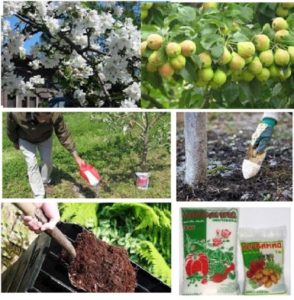 For the tree to take root, it is important to properly care for it after planting. If the apple tree was planted in the fall, pruning is carried out... Leave only the main trunk 60 cm high, making a cut above the healthy kidney.
For the tree to take root, it is important to properly care for it after planting. If the apple tree was planted in the fall, pruning is carried out... Leave only the main trunk 60 cm high, making a cut above the healthy kidney.
The first 2 months the plant is watered weekly with plenty of room temperature water. On hot and dry days, the amount of watering is increased up to 3 times a week. The next day after moistening, the soil is loosened. In the first year, be sure to remove all weeds.
For the prevention of diseases and the appearance of pests in spring and autumn, the tree is sprayed with a solution prepared from a bucket of water and 1 tbsp. l. copper sulfate, or fungicides.
With proper preparation and planting, you will not have to feed the plant for the first 3 years. Further, fertilizers are applied 4 times a year.
Conclusion
Seedlings with a closed root system do not experience much stress when transplanted to a permanent place and quickly adapt to new conditions. An apple tree with roots in an earthen coma is usually planted in the spring or autumn, but sometimes the procedure is carried out in the summer (in June - early July).
